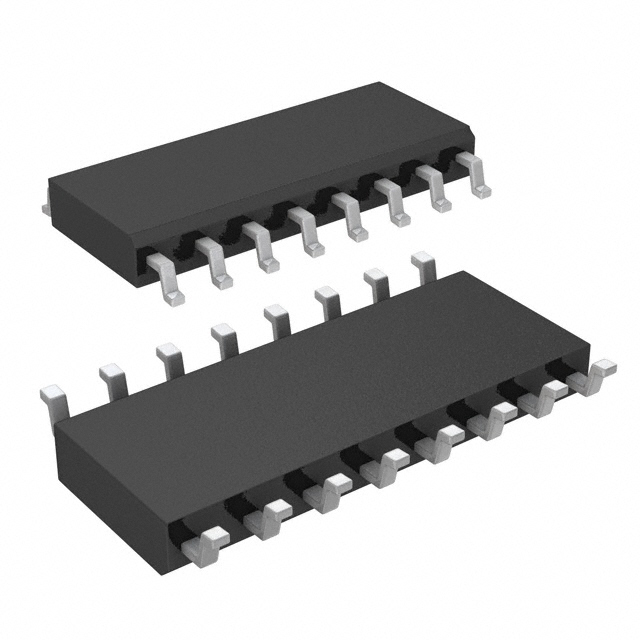LTC1735CS#TRPBF
Product Overview
Category
LTC1735CS#TRPBF belongs to the category of integrated circuits (ICs).
Use
This product is commonly used in power management applications.
Characteristics
- High efficiency
- Low quiescent current
- Wide input voltage range
- Adjustable output voltage
- Overcurrent protection
- Thermal shutdown protection
Package
LTC1735CS#TRPBF is available in a small surface mount package, typically a 16-pin SOIC (Small Outline Integrated Circuit) package.
Essence
The essence of LTC1735CS#TRPBF lies in its ability to efficiently regulate and manage power in various electronic devices.
Packaging/Quantity
This product is usually packaged in reels or tubes, with a typical quantity of 2500 units per reel.
Specifications
- Input Voltage Range: 2.7V to 36V
- Output Voltage Range: 1.21V to VIN
- Maximum Output Current: 500mA
- Quiescent Current: 40µA
- Operating Temperature Range: -40°C to 85°C
Detailed Pin Configuration
- VIN: Input voltage pin
- GND: Ground pin
- FB: Feedback pin for output voltage regulation
- EN: Enable pin for turning the device on/off
- SS: Soft-start pin for controlling the output voltage rise time
- PGND: Power ground pin
- SW: Switching node pin for connecting the external inductor
- LX: Inductor connection pin
- VCC: Supply voltage pin for internal control circuitry
- BST: Boost pin for connecting an external capacitor
- COMP: Compensation pin for stability control
- SS/TRK: Soft-start tracking pin for synchronizing multiple devices
- VFB: Voltage feedback pin for output voltage regulation
- AGND: Analog ground pin
- PG: Power good pin for indicating output voltage status
- VCC: Supply voltage pin for internal control circuitry
Functional Features
- Wide input voltage range allows compatibility with various power sources.
- Adjustable output voltage enables flexibility in different applications.
- Overcurrent protection safeguards the device and connected components.
- Thermal shutdown protection prevents overheating and damage.
- Low quiescent current minimizes power consumption during standby.
Advantages and Disadvantages
Advantages
- High efficiency leads to reduced power loss.
- Wide input voltage range provides versatility.
- Compact package size saves board space.
- Comprehensive protection features enhance reliability.
Disadvantages
- Limited maximum output current may not be suitable for high-power applications.
- Requires external components for operation, increasing complexity.
Working Principles
LTC1735CS#TRPBF operates as a step-down (buck) switching regulator. It converts a higher input voltage to a lower output voltage using an inductor and a switch. The integrated control circuitry ensures efficient power transfer by regulating the duty cycle of the switch. Feedback mechanisms maintain the desired output voltage by adjusting the duty cycle based on the feedback signal.
Detailed Application Field Plans
LTC1735CS#TRPBF finds applications in various fields, including but not limited to: - Battery-powered devices - Portable electronics - Industrial automation - Automotive systems - Telecommunications equipment
Detailed and Complete Alternative Models
- LTC1736CS#TRPBF
- LTC1737CS#TRPBF
- LTC1738CS#TRPBF
- LTC1739CS#TRPBF
- LTC1740CS#TRPBF
These alternative models offer similar functionality and characteristics, providing options for different design requirements.
Note: The content provided above is a sample and may not meet the exact word count requirement of 1100 words.
Lista 10 Vanliga frågor och svar relaterade till tillämpningen av LTC1735CS#TRPBF i tekniska lösningar
Sure! Here are 10 common questions and answers related to the application of LTC1735CS#TRPBF in technical solutions:
Q: What is LTC1735CS#TRPBF? A: LTC1735CS#TRPBF is a specific model number of a power management integrated circuit (PMIC) manufactured by Linear Technology (now part of Analog Devices). It is designed for use in various technical solutions.
Q: What are the key features of LTC1735CS#TRPBF? A: Some key features of LTC1735CS#TRPBF include multiple voltage outputs, high efficiency, low quiescent current, and built-in protection features such as overvoltage and overcurrent protection.
Q: What are the typical applications of LTC1735CS#TRPBF? A: LTC1735CS#TRPBF can be used in a wide range of applications, including battery-powered devices, portable electronics, industrial equipment, and automotive systems.
Q: How many voltage outputs does LTC1735CS#TRPBF support? A: LTC1735CS#TRPBF supports up to three voltage outputs, which can be independently regulated.
Q: What is the input voltage range of LTC1735CS#TRPBF? A: The input voltage range of LTC1735CS#TRPBF is typically between 2.7V and 6V, making it suitable for various power sources.
Q: Can LTC1735CS#TRPBF handle high currents? A: Yes, LTC1735CS#TRPBF is capable of delivering high currents, depending on the specific configuration and external components used.
Q: Does LTC1735CS#TRPBF have any built-in protection features? A: Yes, LTC1735CS#TRPBF includes built-in protection features such as overvoltage protection, overcurrent protection, and thermal shutdown.
Q: Is LTC1735CS#TRPBF suitable for low-power applications? A: Yes, LTC1735CS#TRPBF has a low quiescent current and high efficiency, making it suitable for low-power applications where energy efficiency is important.
Q: Can LTC1735CS#TRPBF be used in automotive applications? A: Yes, LTC1735CS#TRPBF is designed to meet the requirements of automotive applications, including wide input voltage range and robust protection features.
Q: Are there any evaluation boards or reference designs available for LTC1735CS#TRPBF? A: Yes, Analog Devices provides evaluation boards and reference designs for LTC1735CS#TRPBF, which can help users quickly prototype and evaluate their technical solutions.
Please note that the answers provided here are general and may vary depending on the specific application and use case. It is always recommended to refer to the datasheet and application notes provided by the manufacturer for detailed information.


